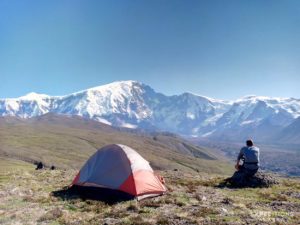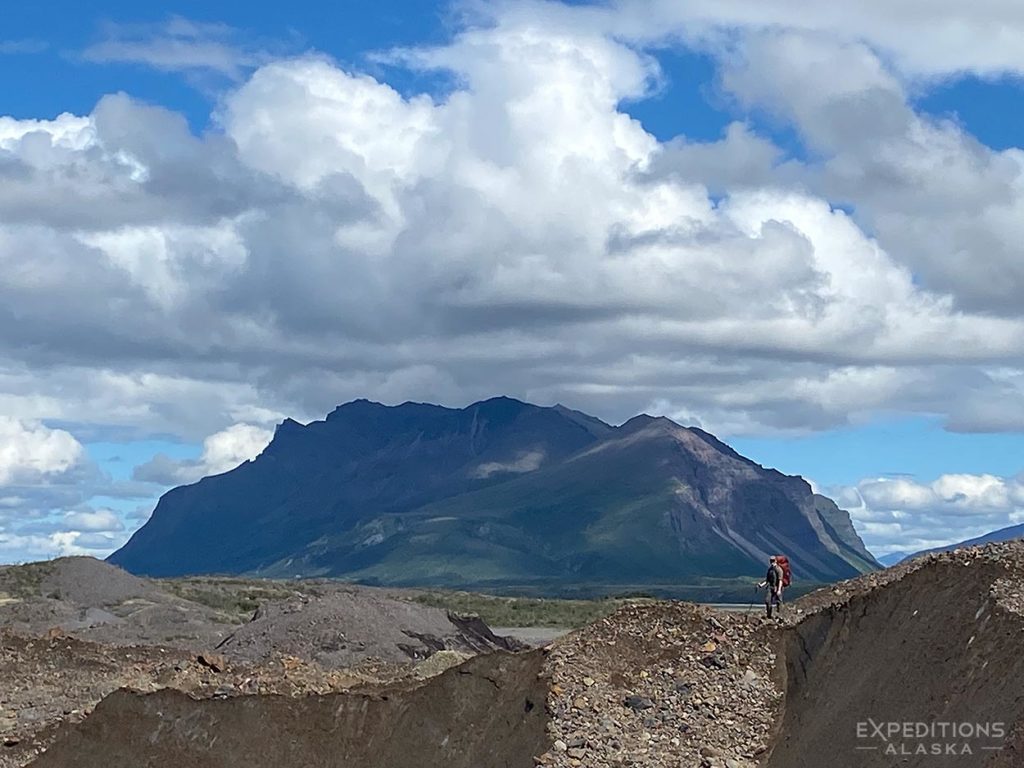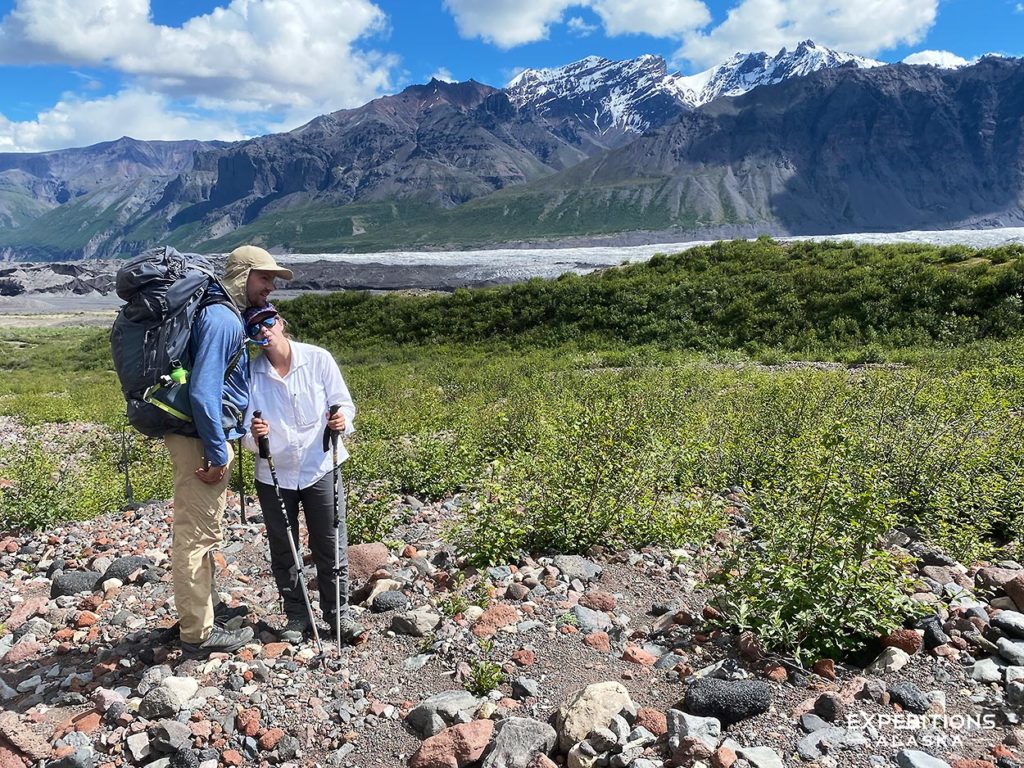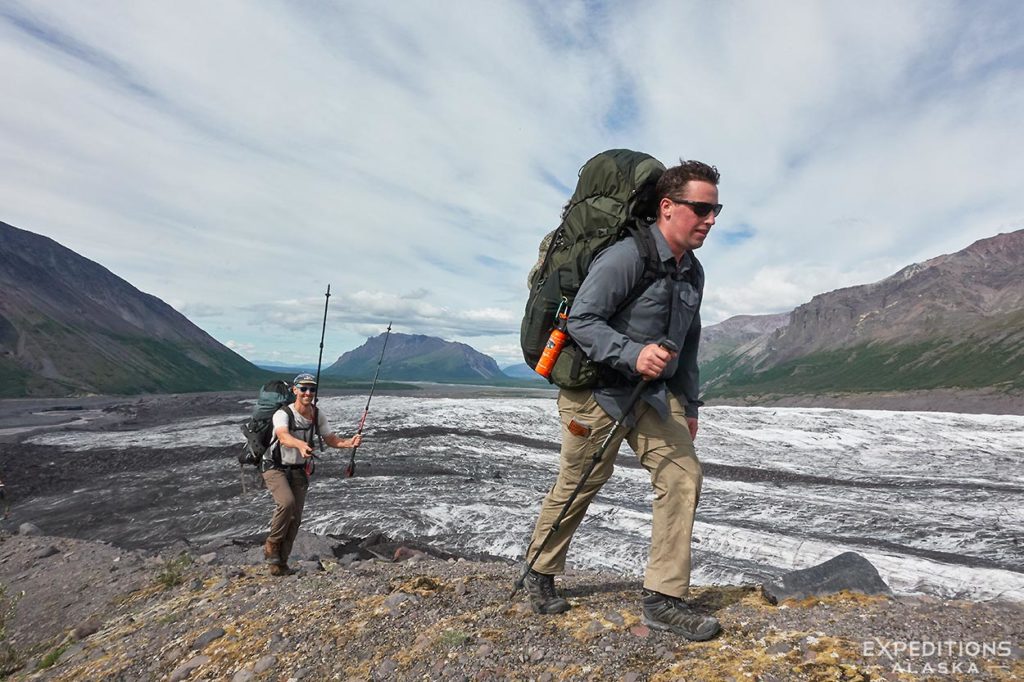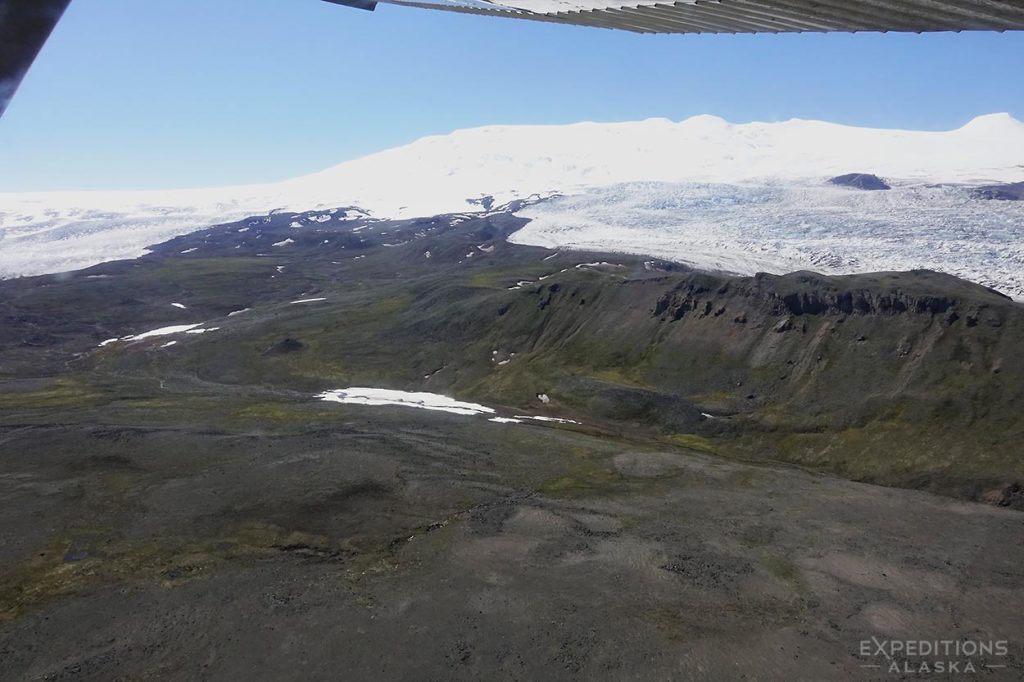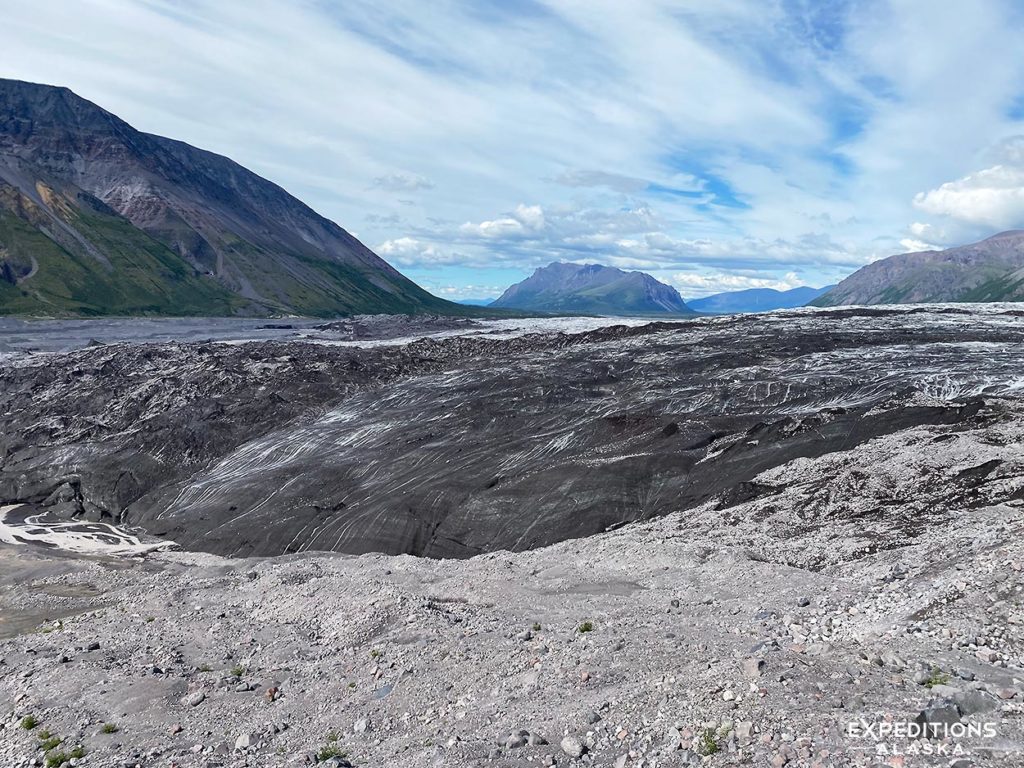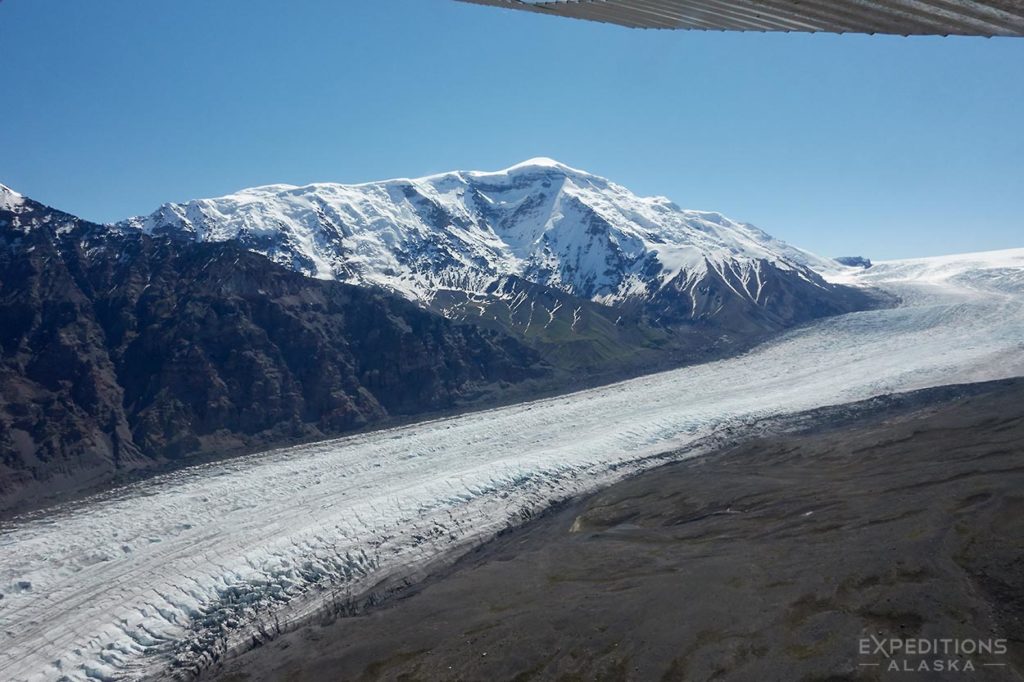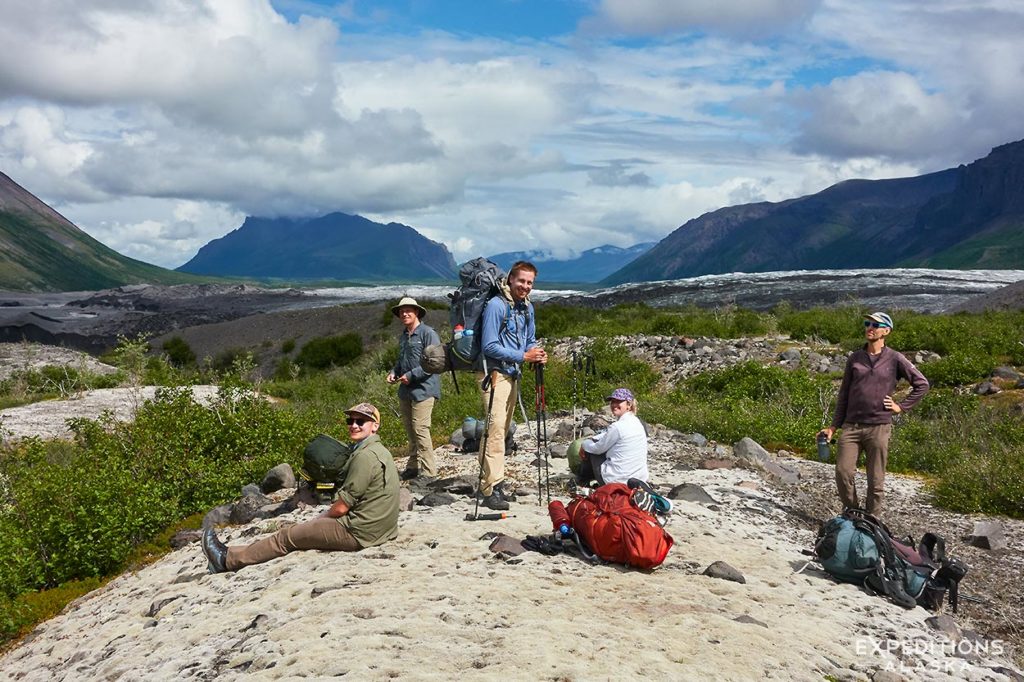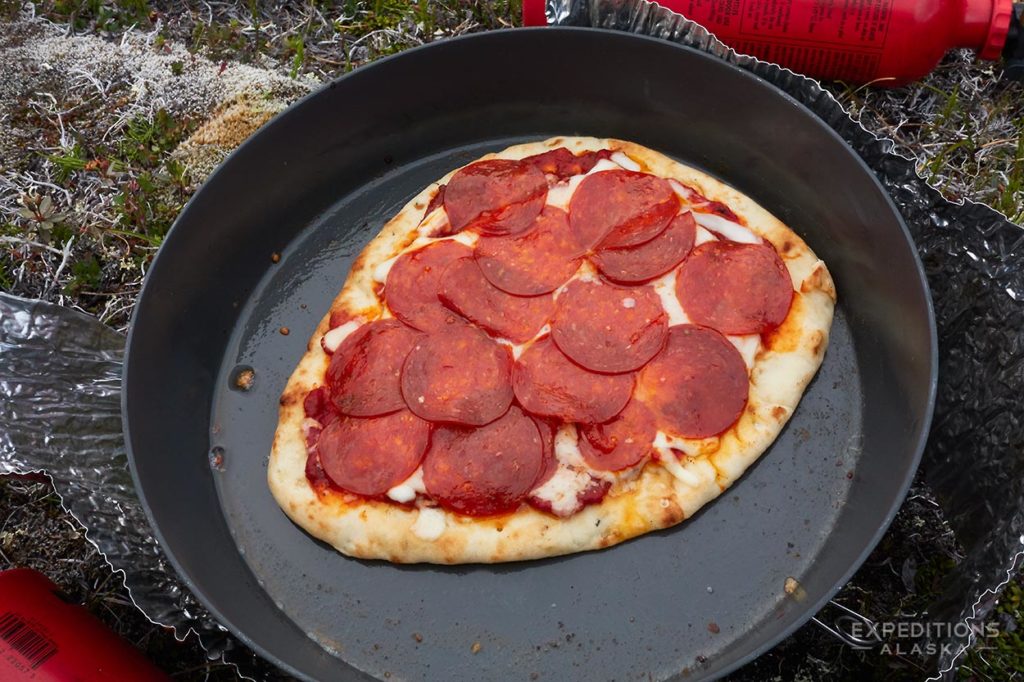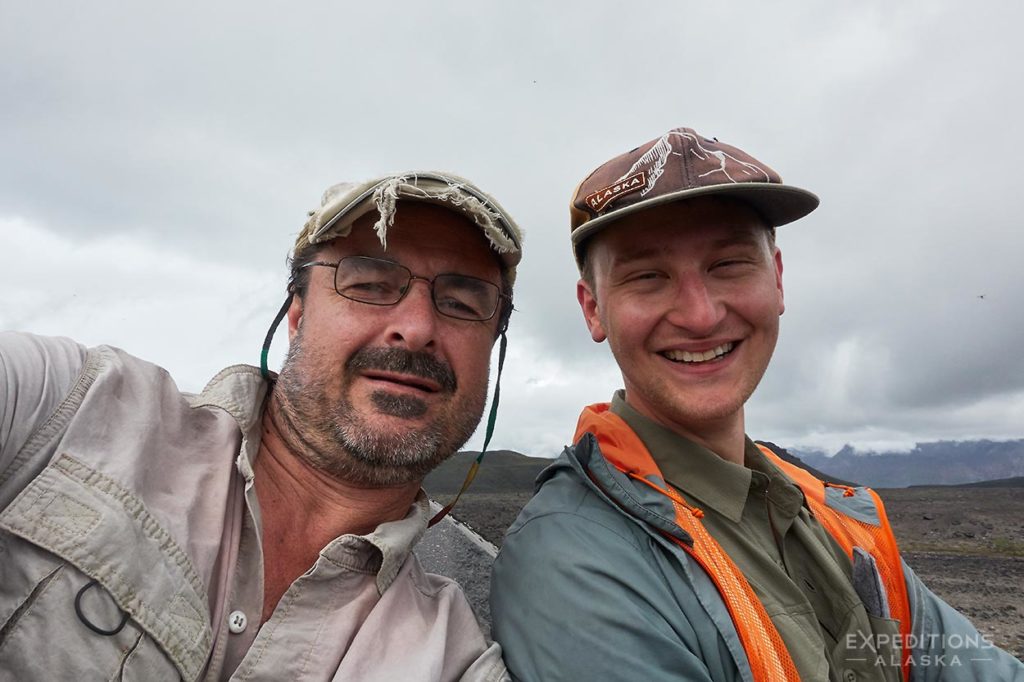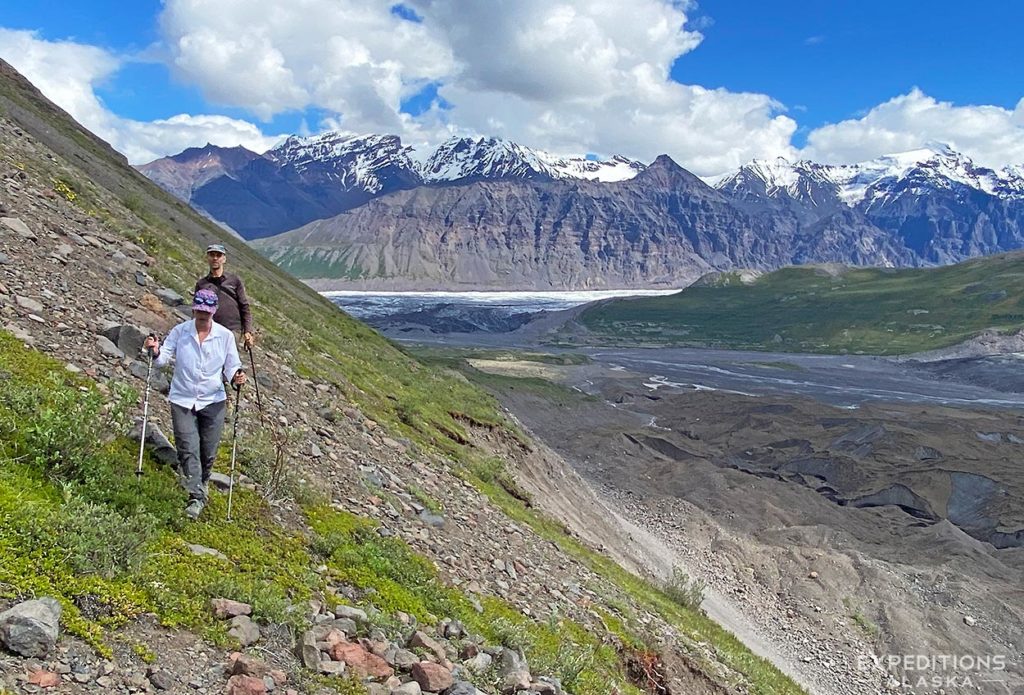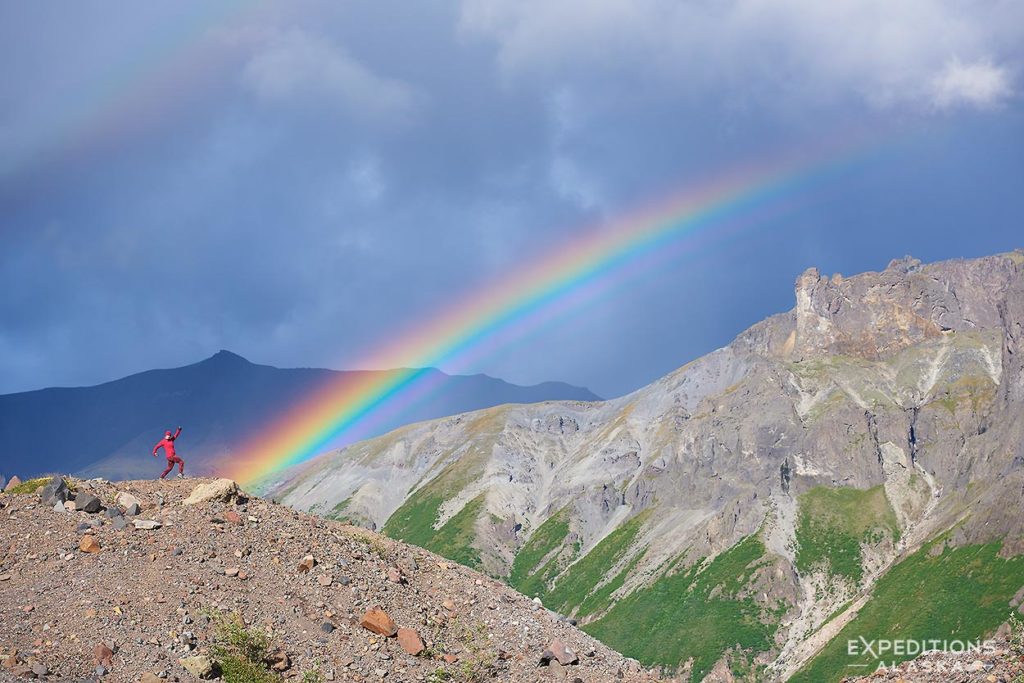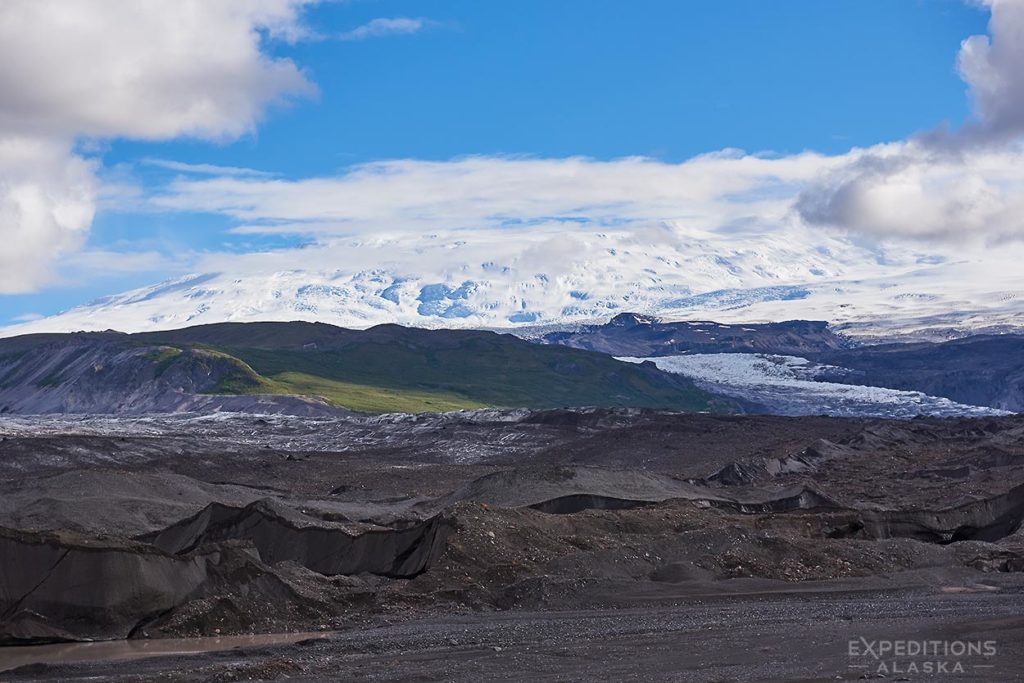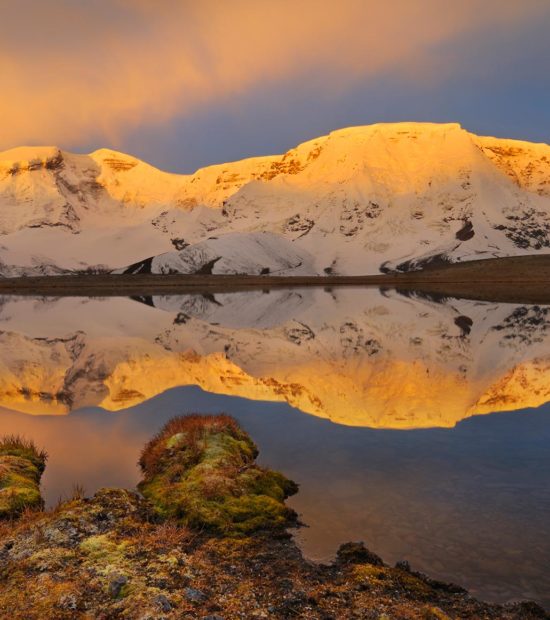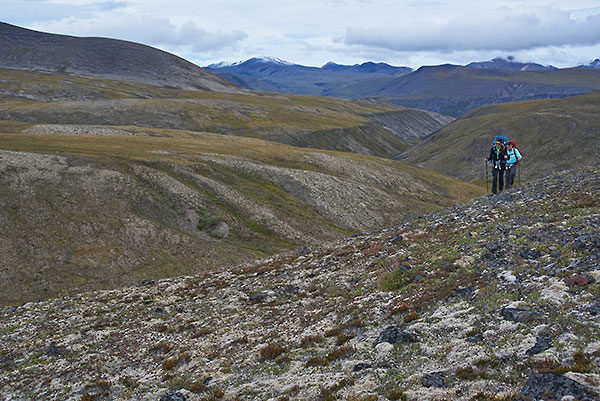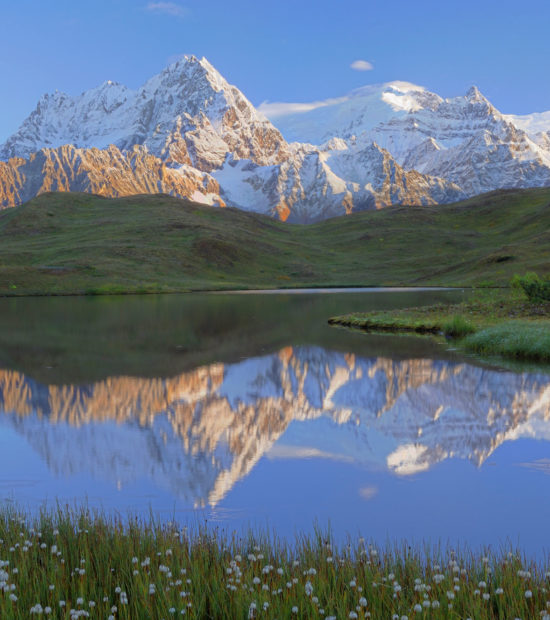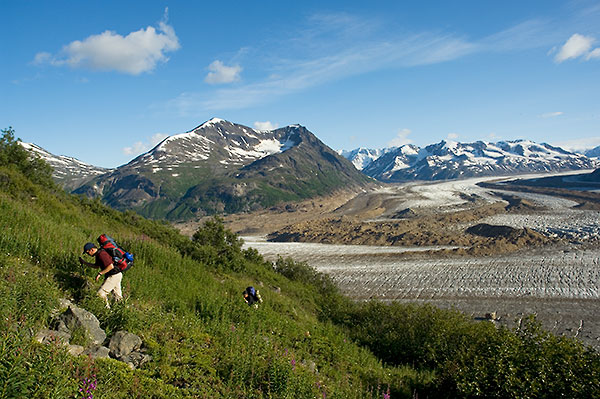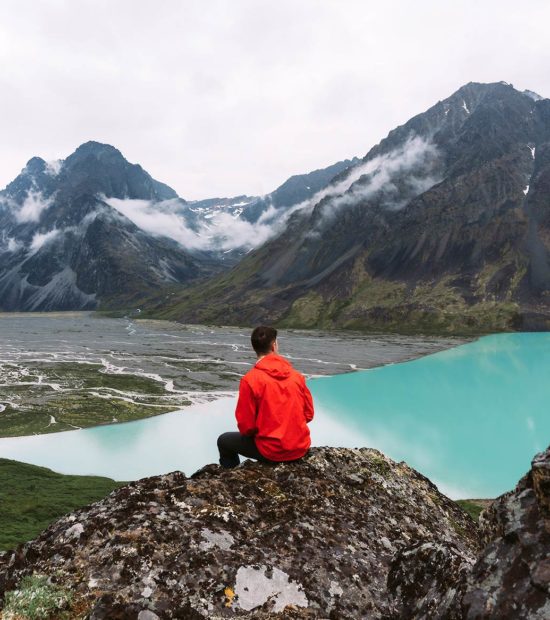The Place
The Wrangell Mountains are yours. Here, the sentinel Mt. Sanford rises from the floor of the valley to dwarf you, me, our camp, our entire sense of being. It’s simply glorious.
Mt Wrangell and it’s offspring sapling, Mt. Zanetti, a combined 27 000’ of volcanic magnificence, present themselves as a wall of ice and snow.
The rugged peaks of the Wrangell Mountain Range encircle this place.
The Copper Glacier is the star of the show, but it’s far from alone. Ice crawls its way down from the massive mountaintops all around us, most of those glaciers unnamed and unexplored. Maps mostly show “crevasses” instead of names and titles.
A Basepack Trip
A Basecamp or Backpack Trip?
This trip is best done as what we call a basepack. Its a combination of basecamping and dayhiking, but with some backpacking as well. it doesn’t work particularly well for those folks who don’t want to backpack at all, but merely set up camp near a landing strip and dayhike and explore. That’s possible, but it’s not, in my opinion, the optimal trip in this location.
Backpacking a little allows us to get to a couple different camping locations that allow us to explore further afield from there. We can go for a day up the glacier. We can traverse the high ridge immediately west of the Copper, with some gorgeous camping and stunning views of the mountains. Mountains so close it feels like you can reach out and touch them.
So yes, this is a backpacking trip, but it involves a couple nights, at least, where we stay put and do some dayhikes. The best of both worlds.
Is this a match?
Who’s It For?
There are a few challenges on this trip, so it’s not a one or two boot location. I think it works best for those folks who can carry a backpack for a day or two, who are comfortable on some different and varying terrains, but don’t want the strain of a weeklong point to point backpack.
We’ll have options for a day of backpacking, a day of rest, a day of hiking, moving camp and hiking another day, then making our way back to the strip for a pickup and a return to Glennallen for some hot Thai food and return to Anchorage.
You must be capable of carrying your pack for day or two, walking over changing terrain, and flexible to not have a set route mapped out; it’ll be different every time.
The Challenges
Walking on a glacier isn’t easy for everyone. It takes some confidence and a little time to get used to it. We’ll take our time.
There’s virtually no bushwhacking here, which is nice. it’s pretty good walking. We do have some moraine and rocks to traverse, and some sidehilling if we go up the valley towards Mt. Sanford. It’s enough to slow some folks down, but nothing to terribly daunting.
We’ll bring microspikes for the ice. Other than that it’s a straightforward backpack and basecamp setup. All the usual gear for a backpack trip. See FAQs below.
Where Are We?
FAQs
-
Is there a basecamp option available?
There is. But it wouldn’t be my first choice for a basecamp. You want to be able to move camp a little, and likely more than once.
-
Is this a good wildlife viewing choice?
It wouldn’t be my recommendation for wildlife. Try the Lake Clark Turquoise Lake basecamp for that. We have seen bear and caribou here, and there are moose in the area, as well as Dall sheep up in the high country. But they’re not always so visible and population densities aren’t particularly high. This trip is about the mountains and the landscape.
-
Backpacking Gear Check List
Here’s a very simple gear check list. Email me if you have any specific gear/food questions. Try not to overpack but don’t short change yourself on essential items like raingear, tent, backpack, boots, sleeping bag, etc. Temperatures can be below freezing with rainy and even snowy weather.
Once we leave Anchorage (or Fairbanks), there are usually NO options for purchasing gear, supplies, food, etc. Anchorage has a great REI and several other gear stores, groceries, etc. The best option is to bring as much as you can with and only use Anchorage for forgotten and last minute items.
Expeditions Alaska will supply bear resistant food canisters, fuel (white gas/coleman fuel, or isobutane mix) and water filter system, First Aid Kit and maps. I highly recommend bringing your own “boo boo kit” – a basic first aid supplies, like sunscreen, blister kit, bandaids, ibuprofen/aleve, etc). We can, if you need, provide tents and food as well. Let me know if you have any specific gear requirements. We’re always glad to work to accommodate them.
I also recommend you see this post for my gear list for more information.
Food
Tent, w/ groundcloth
Sleeping Bag (20degF min)
Backpack – w/ rain cover
Trekking poles – (Provided if necessary, highly recommended*)
Sleeping pad
Lighter/matches
Plastic garbage bags
Eating utensils
bowl, mug
Water bottlesStove (check with Carl)
Cook set (check with Carl)
Fuel bottle (check with Carl)
A couple of gallon sized zip lock bags
Flashlight/headlamp (if before mid-Aug)
CompassLong underwear (wicking, top & bottom)
Long sleeve nylon shirt
Nylon Pants
Fleece Jacket
Additional thermal layer
Rain shell – Pants and Jacket
Wool or fleece gloves
Hat – Cap and 1 Fleece
Wool socks & liners
Backpacking Boots
Stuff Sacks
Sandals/Camp Shoes
Head Net/mosquito Repellent
Toiletry items – Toothbrush, toothpaste, Floss,
Toilet paper
Biodegradable soap, etcBlister stuff (mole foam second skin, etc)
Ibuprofen tablets
Bandaids
Sunscreen
Sunglasses
Lip balmSmall bath towel (2′ long)
Book/Reading material
Camera & Film/memory cards
Brush/comb20˚F, or lower, sleeping bag
Waterproof-breathable rain jacket and pants
Pack rain cover
Fleece jacket (min. 200 wt) or (even better) down/synthetic fill jacket
Sleeping pad
Poncho
Trash bag as rain gear or pack cover
Flip flops for river shoes
35˚F or higher rated sleeping bag -
Itinerary caveats
I put trip itineraries online here to give visitors a more detailed look at some of our trips and what options they include.
I can’t over-emphasize that each is simply an example.
What I work hardest on is tailoring trips to the specific interests and abilities and experience of the people who hike with us. No 2 trips are the same. Where possible we don’t use the same campsites when we do a route and we often even vary the route when appropriate to do so.
I try to be flexible with how far we hike each day and how many days we spend in the backcountry. What time we get up in the morning, for example, is largely up to the trip participants (unless for some reason I feel we need to be up and on the trail by a particular time – this rarely happens).
Itineraries are somewhat fluid. As they should be. Weather, hiker experience and many other factors determine the actual trip.
So don’t expect the itinerary for a trip to match an outline of Day 1 we hike abc, Day 2 we hike xyz, etc, etc. It doesn’t (and in my opinion shouldn’t) work that way. The itineraries listed on this site are
a) to outline the travel time and logistics for you, and
b) attempt to help give you some sense of the route and how it goes.
But with wilderness trail-less backpacking routes, these kinds of structured itineraries are really not very useful.
-
How are the difficulty ratings defined?
Well, “defined” probably isn’t the right word. This is Alaska after all. But this an important question to consider.
One boot equals easiest and five boots the most challenging option. Thanks.
As a general rule I’d suggest rating everything here one notch from what you might be used to (assuming you haven’t hiked in Alaska before). If you consider yourself up for an intermediate level hike assume that a trip rated intermediate here will probably be a bit tougher than you’re expecting. Not impossible, but harder than you think.
As I mentioned above, terrain is the biggest factor here and it’s extremely subjective as to what is difficult terrain and what is not.
Some people really struggle walking over a boulder field, and others don’t find it difficult at all. Some people find sidehilling more difficult, or bushwhacking, and so on. Well, everybody finds sidehilling difficult. But the most common element people struggle with is almost always terrain. Your balance is probably a more important consideration than how miles you run on a treadmill each day in the gym.
One of the best ways to lower a rating is simply give yourself an extra day or 2. Make a 5 day hike a 7 day hike and it’ll much more manageable. Conversely, if you want a challenge give yourself a little less time and you’ll find just about any trip here as challenging as you could want it to be.
Again: please carefully . It’s the boot icon in the sidebar of the trip page.
Thanks.
-
Tell me about this “off trail” backpacking?
Typically, it doesn’t mean we go “off the trail“. It means there is trail. These are two very different things.
Offtrail hiking, or no trail hiking, is hard at times, easy at others, and very hard at others. It’s almost always changing, and not something you should dismiss as irrelevant. In fact, it’s probably the single most important thing to understand about our backpacking trips.
I’ll say that again. Louder.
When we say offtrail backpacking we’re talking about traversing boulder fields, hiking through dense brush, over steep scree and talus slopes and walking for hours on steep grassy mountainsides. All of which are harder than you think they are.
Trust me.
I’ll keep this post brief, but you can read a lot more about this subject (and I recommend that you do) on this blog post.
It’s important.
-
What comes with the Food Add-on?
If you’d like, Expeditions Alaska can handle your backcountry food for the trip. Cost depends on trip length, but it’s typically $325 for a 2-4 day trip, and $425 for a trip 5 days or longer (backcountry days).
We will organize and pack the food, handle all backcountry prep, as well as pots and pans, the stove/s, fuel and your mess kit. Assistance for cleanup and dishes is always appreciated, but not requisite.
NB: this means, if we’re doing food for your trip, you must arrive with requisite space in your backpack for your share of the food. This typically means a BV500, sized 8.7 in. diameter. (22.1cm) x 12.7 in. (32.3cm) height. There’ll also be your mess kit (cup, bowl, cutlery, etc) and maybe some additional group gear, whether it’s a fuel bottle, stove or pan or skillet. In general your guide will carry the bulk of this stuff, but we certainly can’t and don’t intend to carry all of it. So don’t arrive with a backpack packed full, no space left in it, if we’re doing your food for you. Your food goes in your pack.
More info linked on the page below.
All your questions about our backcountry food answered right here.
-
What food do we bring?
Expeditions Alaska offer all guests the option of either providing your own food OR having us provide food for you. The prices posted on our site here do NOT include the additional cost incurred if you would like us to outfit the food for you.
“Goat Trail 15 -23 Aug 2016. Amazing experience. The entire experience was a pleasure. Thanks Carl and thanks for putting us with Rhane. He is an awesome guide and great cook. By the time we were finished, the group felt like we had made a new friend and the experience in the wilderness was life changing. The entire experience with Expeditions Alaska exceeded all my expectations. I am already looking at your website for my next Alaskan adventure. Cheers, GK”
If you would like to bring your own food, here’s a suggestion for novice hikers and those who are inexperienced with backcountry meal preparation. Typically, freeze-dried dinners work well for the inexperienced outdoor chef or those looking for an easier route. Some of the organically grown items, from smaller companies, aren’t bad at all. Mary Jane’s Farm has some great options for starters. They’re fast, easy, lightweight, packable, and require very little cleanup. Try different ones before you pack for your trip.
Less time preparing food allows for more time to enjoy the magnificent surroundings. They don’t taste too bad either!
For lunches I recommend items that don’t need to be cooked. Bagels, pita breads, nuts, dried fruit, candy bars, crackers, etc are great. Something hot for breakfast is a good start to the day, particularly if the weather is cold. Hot drinks such as hot cocoa, tea, or coffee can be very welcome at either end of the day.
If you want me to take care of your food, just let us know. We’re glad to put together a great menu, tailored to your tastes. Good food at the end of a hard day hiking definitely makes a difference!
-
What kind of menu do we get with the food purchase?
Trip dependent. For a 12 day backpack and packraft you can expect a different constitution of food than you’ll see on a 5 day basecamp trip.
Another thing to remember is Expeditions Alaska isn’t a simple “production line” outfit. Guides all have their own systems and menus and favorites, so we don’t have a generic “here’s your trip menu” at all. Menus vary trip to trip. Often a lot.
What I can tell you is you’ll enjoy good food. Really good food. Whether it’s a great pizza, a dish of Pad Thai or greek salad or a lentil soup, I assure you that you’ll appreciate your guides’ culinary expertise. Good food takes a bit extra effort, but can really help bring your trip experience up a notch. Or three.
We do our best to accommodate most dietary requirements, tastes and preferences. We have a comprehensive food form for you to complete and we’ll do our very best from there to put together a menu for the trip that you’ll enjoy.
This is a common question we get , and an important one. So important, it warrants its own page.
All your questions about our backcountry food answered right here.
-
What’s A Fully Outfitted Trip Involve?
That is trip dependent.
For backpacking trips, a fully outfitted option includes your tent (one or two person tent), all your kitchenware, food and cooking by Expeditions Alaska. A typical trip, up to 12 days long, costs an additional $450.00 per person for the fully outfitted option ($350 for 4 day trips or shorter).
Available “á la carte” options are (per person)
Tent $50.00/tent
Food/cooking $325.00 (up to 4 day trip duration)
Food/cooking $425 (any trip 5 days or longer)For personal items such as a backpack, or sleeping pad, talk to me prior to your trip and we’ll see if we can possibly arrange something. If you need a pack I recommend you rent a backpack from a reputable local outfitter. They can find and fit a pack to you rather than “making do” with one of mine that may or may not be a good fit for you.
Items such as BRFC, bear spray, fuel, hiking poles are included gratis with Expeditions Alaska trips. See What’s Included? for more info.
-
Cancellation policy
Reserving your place on a trip requires a 50% deposit. Deposits are non-refundable. All trips be paid in full 45 days prior to the scheduled departure date.
If the client cancels on a trip paid in full, 80% of the price can be deferred and applied to another trip that is scheduled to occur within the next 12 months, provided that all three of the following occurs:
i) Expeditions Alaska, LLC is able to fill the cancelled spot,
ii) Expeditions Alaska LLC is able to fill the the trip that the client cancelled on, and
iii) 30 days (or more) notice is given.If a client cancels a trip and Expeditions Alaska is not able to completely fill that trip, regardless of the number of original participants in that trip, Expeditions Alaska will not defer or refund any portion of the cancelling client’s payment.
Expeditions Alaska, LLC cannot guarantee that a spot will be available on a scheduled trip in the next 12 months. If no spot is available and you cannot use your deposit in those 12 months, the deposit is forfeited and non-refundable.
If cancellation is within 30 days of the trip, only 50% of the fee can be carried over to a future trip. The remainder is forfeited and non-refundable.
No refunds, credit, or other reimbursements are given for cancellations within 14 days of the trip departure.
Expeditions Alaska, LLC reserves the right to cancel and/or modify the itinerary of a trip for any reason. If Expeditions Alaska cancels a trip you will be refunded your payment in full, minus a $250 administrative fees plus any unrecoverable deposits Expeditions Alaska, LLC made to organize the trip. If Expeditions Alaska cancels changes the date of a trip and you can no longer attend, you will be refunded your payment, minus a $250 administrative fees plus any unrecoverable deposits Expeditions Alaska, LLC made to organize the trip.
If weather or other factors delay or impede your trip, there will be no refund of fees. Expeditions Alaska, LLC is not responsible for any other costs incurred by the client as a result of the cancellation, delay, or modification of a trip.
Additional costs incurred through weather delays and itinerary changes are the responsibility of the client.
Additional costs incurred by the client, such as changes to flights or additional costs, etc, are the sole responsibility of the client.
-
What’s Included/Not Included?
All trips and trip prices include the following.
* Professional Guide Service: Experience is paramount, as is a friendly, flexible atmosphere for your trip, and Expeditions Alaska, LLC go out of our way to bring that to the backcountry. I know the routes, the natural history and the place as well as anyone, and all the best campsites! Backcountry camping in Alaska can be intimidating for a novice and even for some intermediate and experienced hikers. A qualified guide service can go a long way to minimizing problems that may come up. Customers returning for
seveneightnineten consecutive hiking trips with Expeditions Alaska speaks volumes for the value of a good guide.* Travel and Accommodations: Expeditions Alaska, LLC typically offers a complete .
For example, for our Wrangell-St. Elias National Park trips, we’ll pick you up from your hotel in Anchorage, drive to McCarthy in our comfortable conversion van, stay the night at the Kennecott River Lodge, enjoy a hot breakfast the following morning in McCarthy, then fly into the backcountry. Backpack and hike for your trip, fly back to McCarthy, have the afternoon in and around McCarthy, exploring the Kennecott Glacier, or the old mines up at Kennecott, spend another night at the Kennecott River Lodge, and drive back to Anchorage the final day, right to your hotel in Anchorage.
For the ANWR trips, we’ll usually travel from Fairbanks to Coldfoot or Kaktovik by plane, then fly into the backcountry. Whether we pick you up at your hotel in Fairbanks or not will depend on whether we’re driving or flying north. If we fly, we’ll meet you at the airport. If we’re driving, we’ll pick you up.
.
* Gear: We can provide all cookware, fuel, etc for the trip. Feel free to let us know if you’d like to bring your own. We can get the fuel you need as it’s not possible for you to fly with any fuel in your luggage. If you would prefer a fully outfitted trip we can accommodate that. You’ll need to bring your personal gear, such as a sleeping bag and backpack. We’ll also provide bear-resistant food canisters and bear spray for the trip. Expeditions Alaska, LLC trips will also provide a cook tent for the trip. We also provide hiking poles for you if you don’t have your own.
* Safety: Any professional guide service puts safety first. This means caution, it means responsibility and it means an excellent knowledge of the area: the terrain, wildlife and travel, backcountry camping and safety. Fully qualified Wilderness First Aid certification. A satellite phone available for emergency backcountry service if necessary and a backup emergency messaging device such as Delorme inReach or PLB. We bring a GPS, map and compass on every route we do. This is an owner-operated business and all participants can feel confident knowing they’re not getting an intern or inexperienced guide for their trip.
* Storage: Extra travel items that won’t be needed while we’re in the backcountry (limited space available).
What’s Not Included?
Expeditions Alaska, LLC do not provide the following unless otherwise specified.
a) food and camping gear — Expeditions Alaska will outfit your trip if you would like us to. For a minimal addition in cost, I’m glad to supply food and camping gear (you will need your own personal gear, such as a sleeping bag, pad, clothes, pack, etc). Any specific items you may need help with, just send me an email or call me and I’ll work it out for you.
b) travel arrangements to Anchorage from outside Alaska.
c) trip insurance. Our suggestion is Travelex.
d) travel meals. Any hotel or lodge meals we eat in the frontcountry are not included in your price. So if we stop to eat along the road, for example, we do not pick up the tab for that.
d) guide gratuities.
Extra Info
The ANWR and Gates of the Arctic National Park trips include all travel (return) from Fairbanks to Coldfoot, or from Fairbanks to Kaktovik, where we fly into the Refuge, as well as rafts, dry bags, etc. The Icy Bay and Malaspina Glacier trips start and end in Yakutat, Alaska. Because of the nature of backcountry adventure, trips vary year to year. Each trip is also available for longer or shorter durations, and trip prices vary accordingly. Similarly, group bookings (3 or more participants) can receive substantial discounts.
For more information, contact us using the Contact Form here.
All clients complete the backcountry waiver before departing for any of our trips.
-
Why are there so many questions?
 Just kidding – it’s really not meant to intimidate anyone. It’s a difficult thing to choose a trip like this, often with relatively little real understanding of how different backpacking here in Alaska is, different even from the more rugged and “wild” parks in the Lower 48 states. Most folks that come up here are not used to backpacking off trail (or, rather, “no trail”), and that really makes a big difference. Your gear choices, your choice of trip, the time you allow for it, and so on, become more critical choices when you’re in a place like this. This page is intended to try help you sort through this and help figure out what kind of trip will work best for you.
Just kidding – it’s really not meant to intimidate anyone. It’s a difficult thing to choose a trip like this, often with relatively little real understanding of how different backpacking here in Alaska is, different even from the more rugged and “wild” parks in the Lower 48 states. Most folks that come up here are not used to backpacking off trail (or, rather, “no trail”), and that really makes a big difference. Your gear choices, your choice of trip, the time you allow for it, and so on, become more critical choices when you’re in a place like this. This page is intended to try help you sort through this and help figure out what kind of trip will work best for you.At the same time, the rewards and the thrill of a place like this are also unique. I’ve no question at all that if you’ve read this far, you’ll love your Alaska backpacking trip, whether it’s with me, or another guiding service, or a trip you take on your own. Just be careful out there.
Happy Trails!
-
I Have More Questions
I know you do. I do as well.
I recommend starting with the General Trip FAQ page
More questions? Email me or call me and we’ll go through them.
Upon your reservation I’ll also send out a comprehensive trip information packet that covers just about everything and more you might imagine about your trip.
Logistics
A relatively simple trip for a fly in trip. We don’t need overnight lodging before and after the trip, as we can fly in the same day we depart Anchorage. So less travel time than some of the McCarthy-based trips we do.
A 30 minute flight in to the park, on wheels. Depending on group size, it will likely be 2 flights.
We backpack and camp and hike til we get back to the strip for our return flight to Glennallen, a hot meal and return travel to Anchorage.
Itinerary
Always weather dependent.
Definitely read, and maybe re-read, the Itinerary Caveats section in the FAQs above. These outlines are, at best, only a sample or tentative itinerary, not something set in stone at all.
That said, read on …

